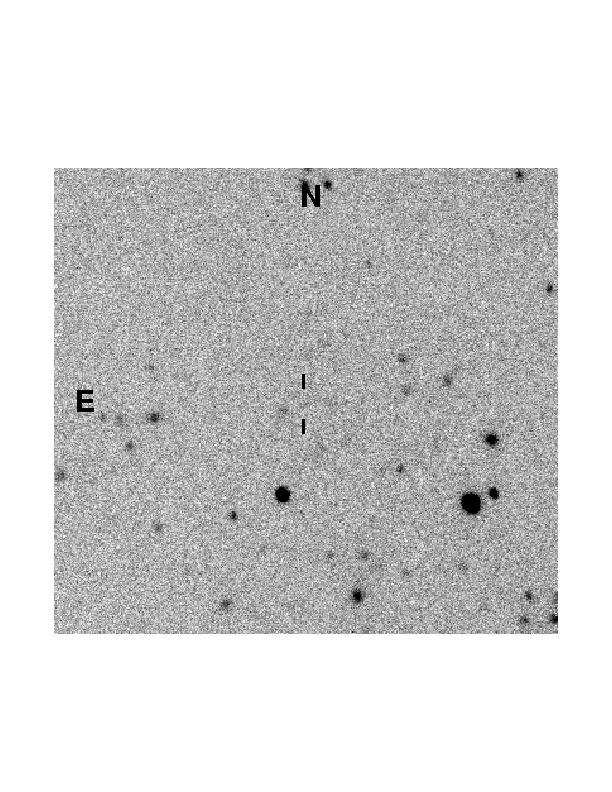
Gamma-ray Burst 000727

On July 27, 2000 at 19:42:36 UT a burst was detected by
Ulysses, Konus-Wind, and NEAR.
With the Sun being only 45 degree away, this GRB is hardly observable
in the optical band.
(All information courtesy of the instrument teams.)
 Previous IAU Circulars
Previous IAU Circulars
 Results of Observations
Results of Observations
- GCN notice #754
K. Hurley, on behalf of the Ulysses GRB team, E. Mazets and S. Golenetskii,
on behalf of the Konus-Wind GRB team, and T. Cline, on behalf of the
NEAR and Konus-Wind GRB teams, report:
Ulysses, Konus-Wind, and NEAR detected this burst at 70956 s UT.
As observed by Ulysses, it had a duration of ~10 s, a 25-150 keV
fluence of 2.6 x 10^-6 erg/cm^2, and a peak flux over 0.5 s
of 4.3 x 10^-6 erg/cm^2 s^-1. We have localized it to a
preliminary 3 sigma error box whose area is ~25 sq. arcmin. and
whose coordinates are:
RA(2000) DEC(2000)
11 h 45 m 10.54 s 17 o 24 ' 34.44 " (CENTER)
11 h 45 m 14.07 s 17 o 25 ' 11.88 " (CORNER)
11 h 44 m 35.46 s 17 o 31 ' 24.63 " (CORNER)
11 h 45 m 45.47 s 17 o 17 ' 43.53 " (CORNER)
11 h 45 m 7.01 s 17 o 23 ' 56.99 " (CORNER)
This error box can be refined.
(NOTE: Ulysses and NEAR have had very high background rates
for the past several weeks due to solar protons, which explains
the the recent decrease in the IPN event rate. Both instruments
have now returned to their normal background rates.)
- GCN notice #755
A. Henden (USRA/USNO) reports on behalf of the USNO GRB team:
We have imaged the entire IPN error box (Hurley, et al. GCN 754)
for GRB 000727 with the NOFS 1.0-m telescope with a
Tektronix 2048x2048 CCD and Cousins R filter. Conditions
were marginal with poor seeing, bright sky and light cirrus.
Compared against the POSS-II red plate, we reach approximately
the same depth. Only one, very marginal, object appears on
our frame but does not appear on the POSS-II scan. This
object is likely just a red star, but is reported here for
completeness. The J2000 coordinates and USNO-A2.0 red
magnitude are:
11:45:26.90 +17:22:20.9 20.7 +/- 0.3
The magnitude is based on the bright star just to the south
at J2000 position and USNO-A2.0 red magnitude of:
11:45:27.84 +17:21:33.1 15.70
A 4.5x4.5 arcmin finding chart for this object is
embarrassingly given at:
ftp://ftp.nofs.navy.mil/pub/outgoing/aah/grb/grb000727.jpg
and reproduced below.

- 1004.3378 from 21 Apr 10
Rachid Ouyed et al.: Quark-Novae in post-accretion Low-Mass X-ray Binaries: A universal model for short-hard Gamma-Ray Bursts
Physics&Astronomy, Louisiana State University, LA, USA, (3) Physics&Astronomy, California State University Long Beach, CA, USA, (4) Institute
of Mathematical Sciences, India)
We show that several features reminiscent of short-hard GRBs arise naturally when Quark-Novae occur in post-accretion low-mass X-ray binaries
with a circumbinary disk. Post-accretion conditions in a neutron star-white dwarf binary are just right for the conversion of the neutron star
to a quark star (Quark-Nova). In our model, the subsequent interaction of material from the neutron star's ejected crust with the circumbinary
disk explains the duration, variability and near-universal nature of the prompt emission in short-hard GRBs. We also describe a statistical
approach to ejecta break-up and collision to obtain the photon spectrum in our model, which turns out remarkably similar to the empirical Band
function (Band et al. 1993). We apply the model to the fluence and spectrum of GRB 000727, GRB 000218, and GRB980706A obtaining excellent fits.
Extended emission (spectrum and duration) is explained by shock-heating and ablation of the white dwarf by the highly energetic ejecta.
Depending on the orbital separation when the Quark-Nova occurs, we isolate interesting regimes within our model when both prompt and extended
emission can occur. We find that the spectrum can carry signatures typical of Type Ib/c SNe, thus providing an alternative to the collapsar
scenario. Late X-ray activity is due to accretion onto the quark star as well as its spin-down luminosity, while afterglows arise from the
expanding shell of material from the shock-heated expanding circumbinary disk. We find a correlation between the duration and spectrum of
short-hard GRBs as well as modest hard-to-soft time evolution of the peak energy.
Back to JG's
homepage
Jochen Greiner, last update: 21-Apr-2010
[Disclaimer]
![]() Previous IAU Circulars
Previous IAU Circulars 